Study on Noise Reduction with Paving Different Low Noise Pavement Materials
Abstract
:1. Introduction
2. Experimental Setup of Testing Lanes
2.1. Pavement Mixtures in Experimental Road Section
2.2. Combination of Low Noise Pavements
- Type I: The laying range is from K159+100 to K159+400, with a total of 300 m in length. Both the inner lane and the outer lane use a 2.5 cm PUC-10. The PUC-10 mainly uses fine particle size aggregates to increase the smoothness of the pavement and thus to reduce the noise generated by tire vibration, and it also has some sound absorption ability at the same time. Due to the thickness issue, compared with PAC-13, the peak frequency of PUC-10 is much higher, while the absorption coefficient of the peak value is slightly lower.
- Type II: The laying range is from K159+400 to K159+700, with a total of 300 m in length. The inner lane and the outer lane use a double-layer porous asphalt pavement, where the bottom layer uses 4.5 cm PAC-13 and the top layer uses 2.5 cm PUC-10. The double-layer porous pavement has the noise reduction performance of both single-layer porous asphalt pavement and thin-layer asphalt pavement, which is shown as follows: First, within the effective frequency range, there are two peaks of sound absorption coefficient, so the noise absorption effect is more obvious [24]; Second, the top layer has a fine particle size with a lower value of mean profile depth (MPD), and thus it can reduce the vibration and the noise caused by the contact between the tire and the pavement [25]; Third, the absorption layer of double porous pavement is thicker, and the first effective absorption peak frequency can be lower.
- Type III: The laying range is from K159+700 to K160+700, with a total of 1000 m in length. The inner lane uses a 2.5 cm PUC-10, and the outer lane uses 4.5 cm PAC-13+2.5 cm PUC-10 double-layer asphalt pavement. This combination considers that the inner lane is mainly used for light vehicles, while the outer lane is mainly used for heavy ones. The top layers of the combination use fine particle size aggregates to reduce the noise generated by tire vibration [26]. Compared with light vehicles, the tire/road noise generated by heavy vehicles is more dominant at lower frequencies than light vehicles, and the engine noise of heavy vehicles also has more contributes, so double-layer porous asphalt pavements are used in the outer lane. After considering the drainage requirements of road cross-sectional pavement structure, the construction convenience, and the double-layer porous pavement sound absorption capability, the emergency lane also uses double-layer porous asphalt pavement.
- Type IV: The laying range is from K160+700 and K161+300, with a total of 600 m in length. Both the inner lane and the outer lane use a single-layer porous asphalt pavement 4.0 cm PAC-13. PAC-13 is the most widely used pavement to mitigate noise in China nowadays, which can reduce traffic noise by absorbing tire/road noise.
3. Tire/Road Noise Measurement with CPX
4. Measurement Results
4.1. Speed of the Trailer at 60 km/h
4.2. Speed of the Trailer at 80 km/h
4.3. Speed of the Trailer at 100 km/h
5. Analysis of Noise Reduction Performance of Composite Pavement
6. Conclusions
Author Contributions
Funding
Institutional Review Board Statement
Informed Consent Statement
Data Availability Statement
Conflicts of Interest
References
- Vazquez, V.F.; Paje, S.E. Study of the road surface properties that control the acoustic performance of a rubberised asphalt mixture. Appl. Acoust. 2016, 102, 33–39. [Google Scholar] [CrossRef]
- Freitas, E.; Mendonça, C.; Santos, J.A.; Murteira, C.; Ferreira, J.P. Traffic noise abatement: How different pavements, vehicle speeds and traffic densities affect annoyance levels. Transp. Res. Part D Transp. Environ. 2012, 17, 321–326. [Google Scholar] [CrossRef]
- Li, T. A State-of-the-Art Review of Measurement Techniques on Tire–Pavement Interaction Noise. Measurement 2018, 128, 325–351. [Google Scholar] [CrossRef]
- ISO 11819-1:1997. Acoustics-Measurement of the Influence of Road Surfaces on Traffic Noise–Part 1: Statistical Pass-by Method; International Organization for Standardization: Geneva, Switzerland, 1997; Available online: https://www.iso.org/standard/20232.html (accessed on 28 October 2021).
- ISO 11819-4:2013. Acoustics–Method for Measuring the Influence of Road Surfaces on Traffic Noise–Part 4: SPB Method Using Backing Board; International Organization for Standardization: Geneva, Switzerland, 2013; Available online: https://www.iso.org/standard/61070.html (accessed on 28 October 2021).
- Khan, V.; Biligiri, K.P. Evolution of tyre/road noise research in India: Investigations using statistical pass-by method and noise trailer. Int. J. Pavement Res. Technol. 2018, 11, 253–264. [Google Scholar] [CrossRef]
- Cesbron, J.; Klein, P. Correlation between tyre/road noise levels measured by the Coast-By and the Close-ProXimity methods. Appl. Acoust. 2017, 126, 36–46. [Google Scholar] [CrossRef]
- Knabben, R.M.; Triches, G.; Vergara, E.F.; Gerges, S.N.; van Keulen, W. Characterization of tire-road noise from Brazilian roads using the CPX trailer method. Appl. Acoust. 2019, 151, 206–214. [Google Scholar] [CrossRef]
- AASHTO TP 99. Standard Method of Test for Determining the Influence of Road Surfaces on Traffic Noise Using the Continuous-Flow Traffic Time-Integrated Method (CTIM); American Association of State and Highway Transportation Officials: Washington, DC, USA, 2015; Available online: https://infostore.saiglobal.com/en-gb/standards/aashto-tp-99-2013-1442_saig_aashto_aashto_2628931/ (accessed on 28 October 2021).
- ISO 11819-2:2017. Acoustics-Measurement of the Influence of Road Surfaces on Traffic Noise-Part 2: The Close-Proximity Method; International Organization for Standardization: Geneva, Switzerland, 2017; Available online: https://www.iso.org/standard/39675.html (accessed on 28 October 2021).
- AASHTO TP 76-12. Standard Method of Test for Measurement of Tire/Pavement Noise Using the On-Board Sound Intensity (OBSI) Method; American Association of State and Highway Transportation Officials: Washington, DC, USA, 2008; Available online: https://www.stdlink.com/standards/aashto-tp-76-12.html (accessed on 28 October 2021).
- AASHTO T 360-16. Standard Method of Test for Measurement of Tire/Pavement Noise Using the On-Board Sound Intensity (OBSI) Method; American Association of State and Highway Transportation Officials: Washington, DC, USA, 2016; Available online: https://standards.globalspec.com/std/14232667/aashto-t-360 (accessed on 28 October 2021).
- Mioduszewski, P.; Gardziejczyk, W. Inhomogeneity of low-noise wearing courses evaluated by tire/road noise measurements using the close-proximity method. Appl. Acoust. 2016, 111, 58–66. [Google Scholar] [CrossRef]
- Liao, G.; Sakhaeifar, M.S.; Heitzman, M.; West, R.; Waller, B.; Wang, S.; Ding, Y. The effects of pavement surface characteristics on tire/pavement noise. Appl. Acoust. 2014, 76, 14–23. [Google Scholar] [CrossRef]
- Licitra, G.; Teti, L.; Cerchiai, M. A modified Close Proximity method to evaluate the time trends of road pavements acoustical performances. Appl. Acoust. 2014, 76, 169–179. [Google Scholar] [CrossRef]
- Donavan, P. Evaluation of the ASTM Standard Reference Test Tire for purposes of standardized measurement of on-bound tire?pavement noise. J. Acoust. Soc. Am. 2008, 123, 3390. [Google Scholar] [CrossRef]
- Licitra, G.; Teti, L.; Cerchiai, M.; Bianco, F. The influence of tyres on the use of the CPX method for evaluating the effectiveness of a noise mitigation action based on low-noise road surfaces. Transp. Res. Part D Transp. Environ. 2017, 55, 217–226. [Google Scholar] [CrossRef]
- ISO/TS 11819-3:2017. Acoustics-Measurement of the Influence of Road Surfaces on Traffic Noise-Part 3: Reference Tyres; International Organization for Standardization: Geneva, Switzerland, 2017; Available online: https://www.iso.org/standard/70808.html (accessed on 28 October 2021).
- ASTM F2493-20. Standard Specification for P225/60R16 97S Radial Standard Reference Test Tire; ASTM International: West Conshohocken, PA, USA, 2020; Available online: https://standards.globalspec.com/std/14364242/astm-f2493-20 (accessed on 28 October 2021).
- Ren, W.; Han, S.; Fwa, T.F.; Zhang, J.; He, Z. A new laboratory test method for tire-pavement noise. Measurement 2019, 145, 137–143. [Google Scholar] [CrossRef]
- Soares, F.; Freitas, E.; Cunha, C.; Silva, C.; Lamas, J.; Mouta, S.; Santos, J.A. Traffic noise: Annoyance assessment of real and virtual sounds based on close proximity measurements. Transp. Res. Part D Transp. Environ. 2017, 52, 399–407. [Google Scholar] [CrossRef] [Green Version]
- Gołebiewski, R.; Makarewicz, R.; Nowak, M.; Preis, A. Traffic noise reduction due to the porous road surface. Appl. Acoust. 2003, 64, 481–494. [Google Scholar] [CrossRef]
- JTG B01-2014. Technical Standard of Highway Engineering; Ministry of Transport: Beijing, China, 2014. [Google Scholar]
- Teti, L.; de León, G.; Del Pizzo, A.; Moro, A.; Bianco, F.; Fredianelli, L.; Licitra, G. Modelling the acoustic performance of newly laid low-noise pavements. Constr. Build. Mater. 2020, 247, 118509. [Google Scholar] [CrossRef]
- Vazquez, V.F.; Hidalgo, M.E.; Garcia-Hoz, A.M. Tire/road noise, texture, and vertical accelerations: Surface assessment of an urban road. Appl. Acoust. 2020, 160, 107153. [Google Scholar] [CrossRef]
- Winroth, J.; Kropp, W.; Hoever, C.; Höstmad, P. Contact stiffness considerations when simulating tyre/road noise. J. Sound Vib. 2017, 409, 274–286. [Google Scholar] [CrossRef]
- Anfosso-Ledee, F.; Pichaud, Y. Temperature effect on tyre-road noise. Appl. Acoust. 2007, 68, 1–16. [Google Scholar] [CrossRef]
- Wehr, R.; Fuchs, A.; Aichinger, C. A combined approach for correcting tyre hardness and temperature influence on tyre/road noise. Appl. Acoust. 2018, 13, 110–118. [Google Scholar] [CrossRef]
- ISO/TS 13471–1: 2017. Acoustics-Temperature Influence on Tyre/Road Noise Measurement-Part 1: Correction for Temperature When Testing with the CPX Method; International Organization for Standardization: Geneva, Switzerland, 2017; Available online: https://www.iso.org/standard/25630.html (accessed on 28 October 2021).
- Jonasson, H. Acoustic Source Modelling of Nordic Road Vehicles. SP Rapp. 2006, 12. Available online: https://docplayer.net/52963176-Acoustic-source-modelling-of-nordic-road-vehicles.html (accessed on 28 October 2021).
- National Research Council. Highway Capacity Manual 2010; Transportation Research Board: Washington, DC, USA, 2010.
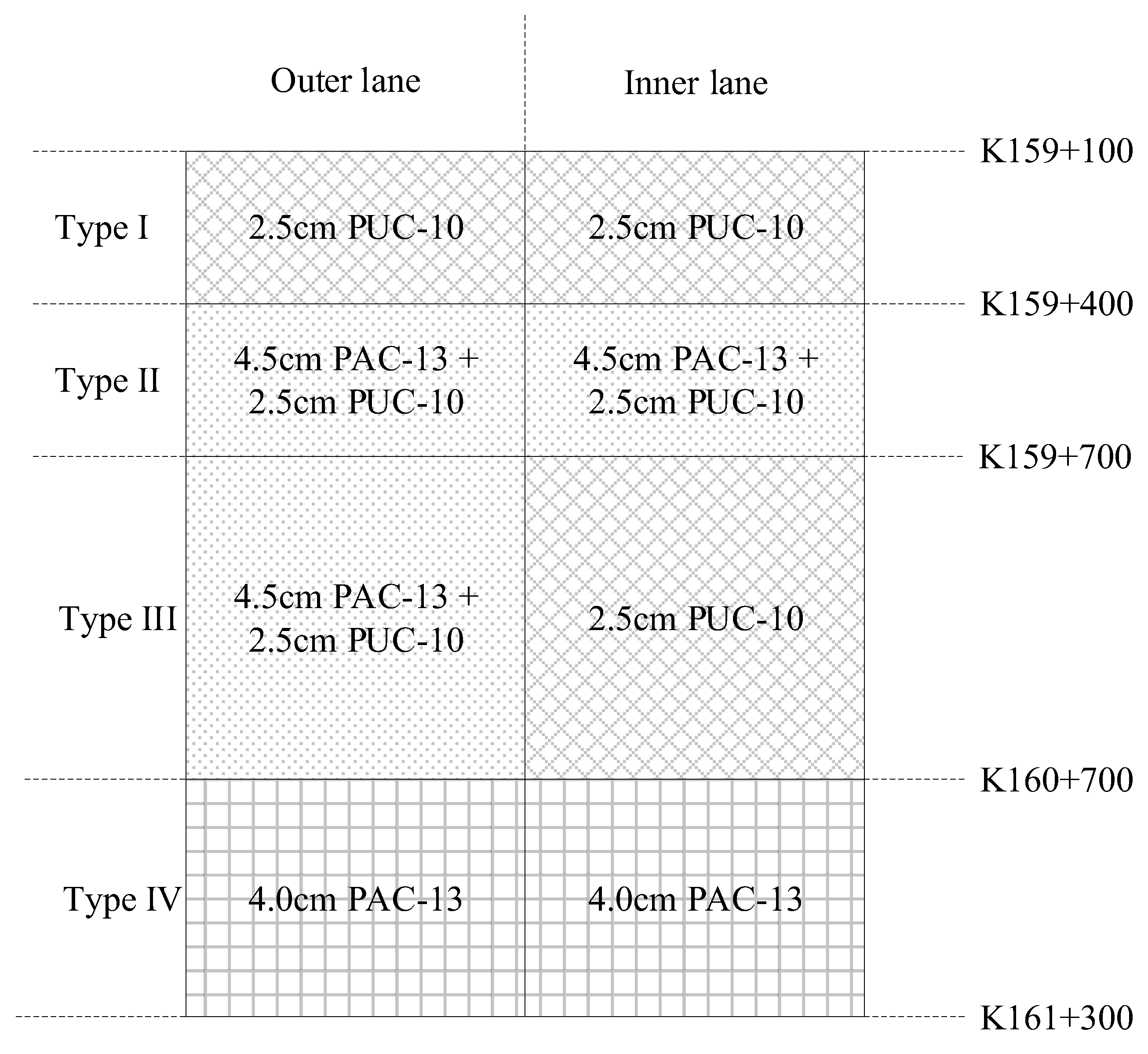
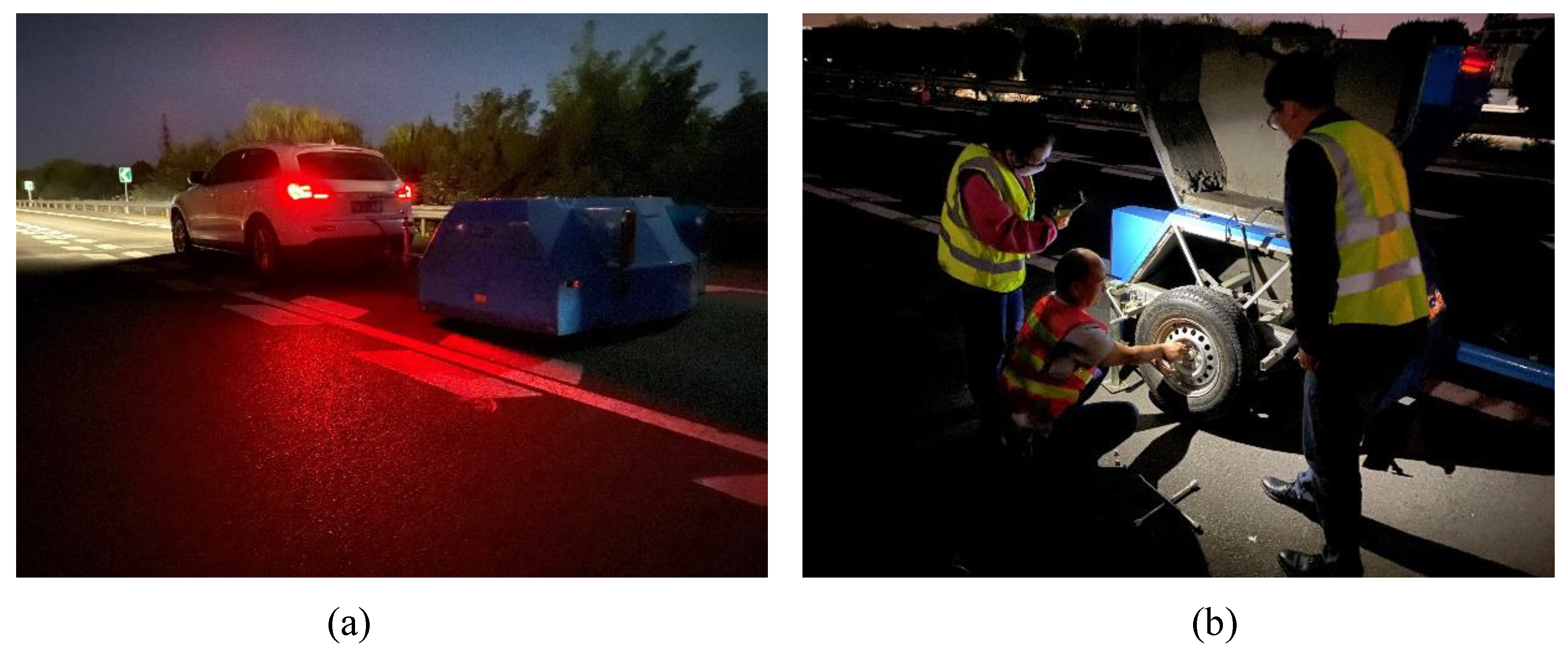
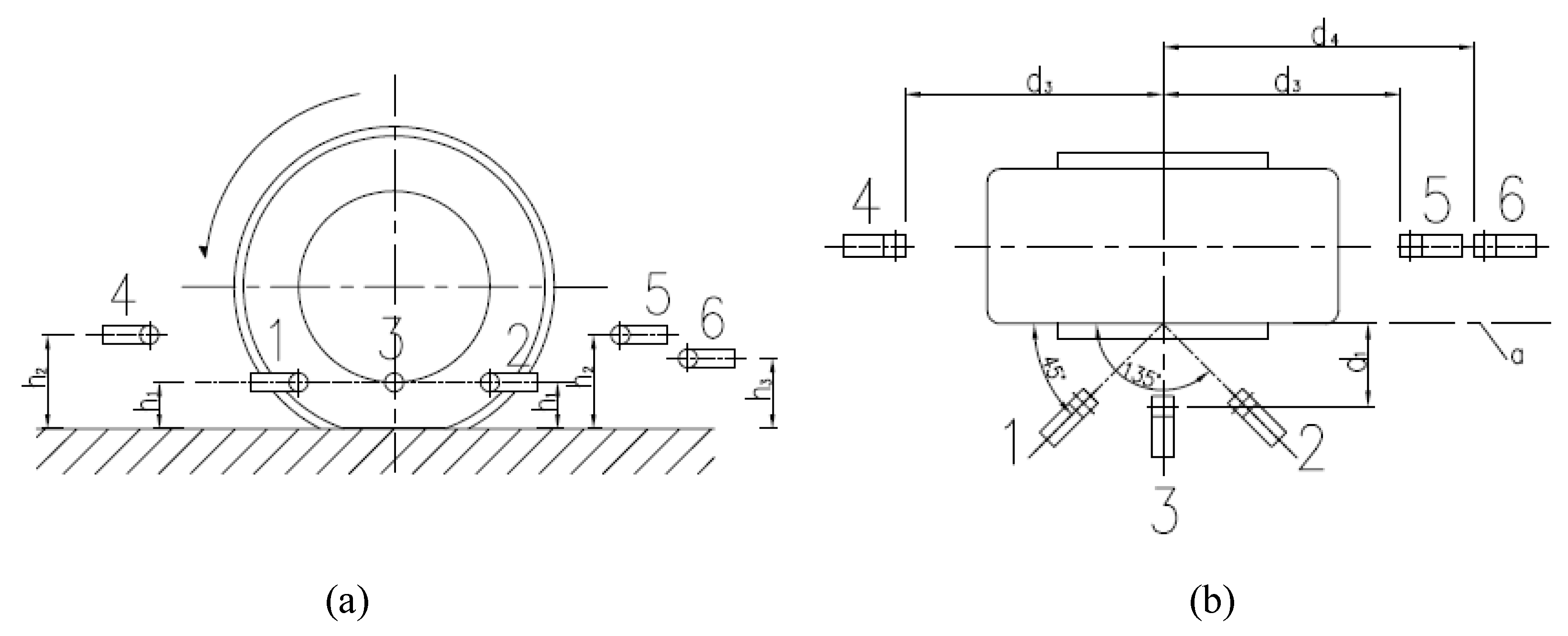

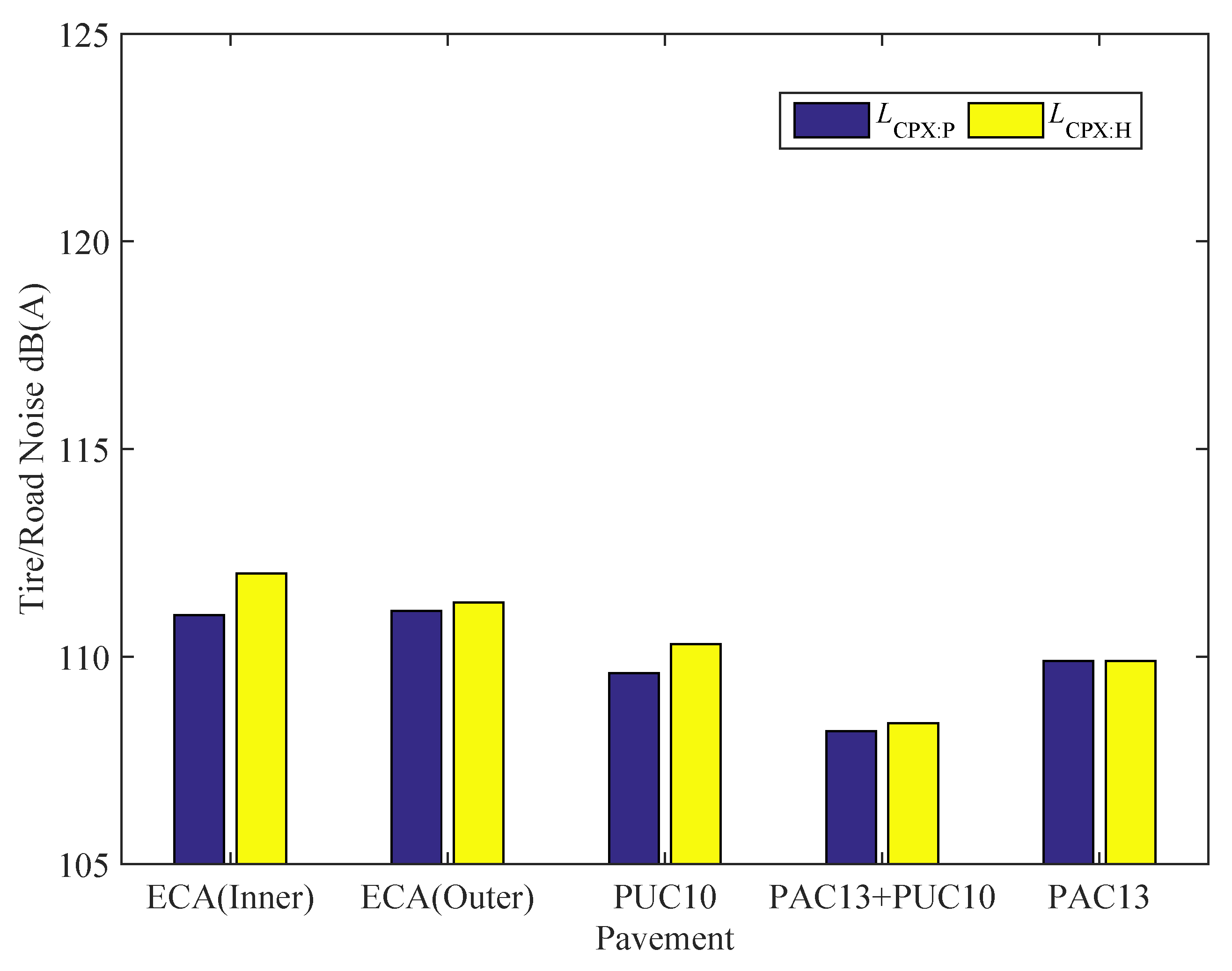
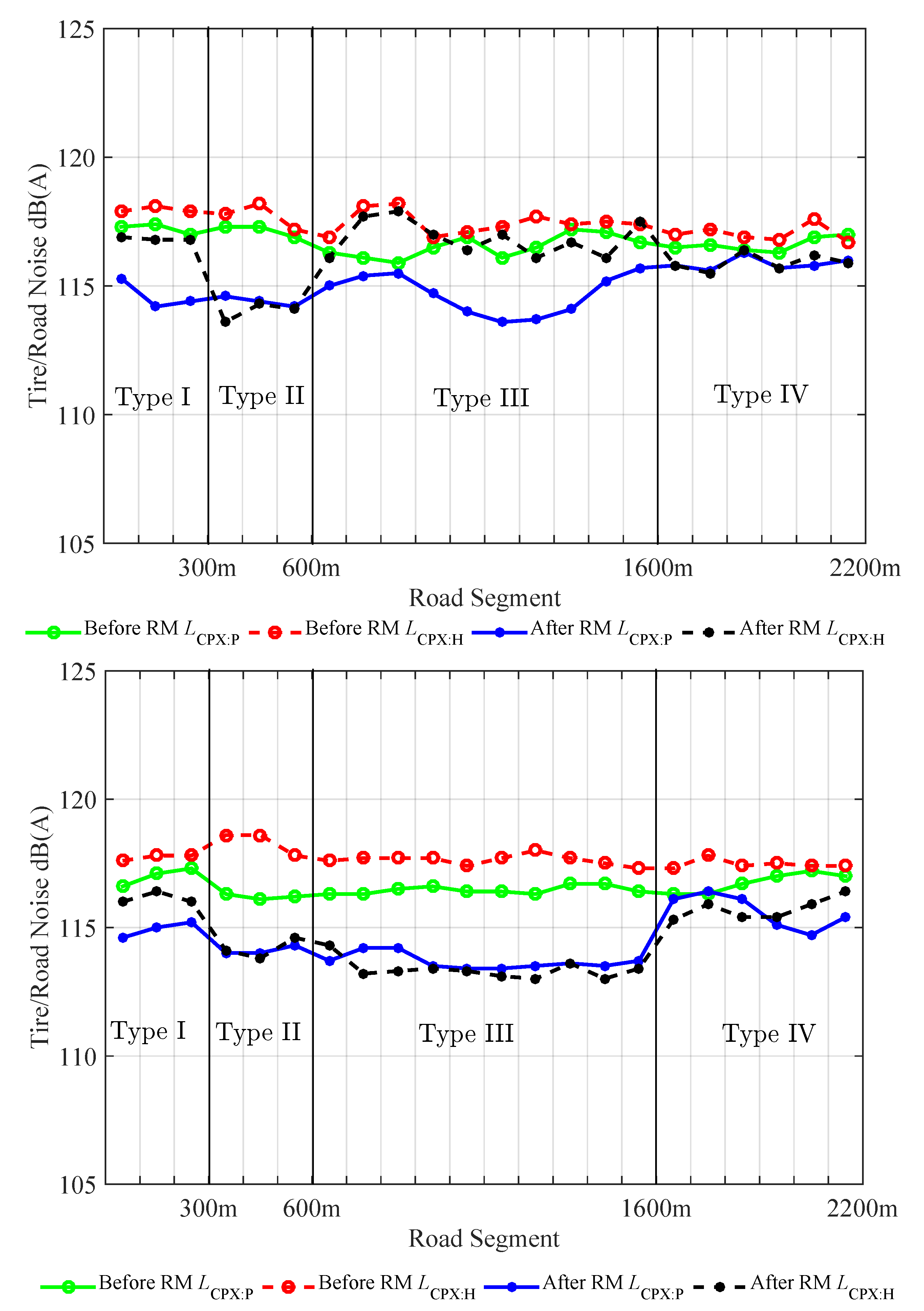
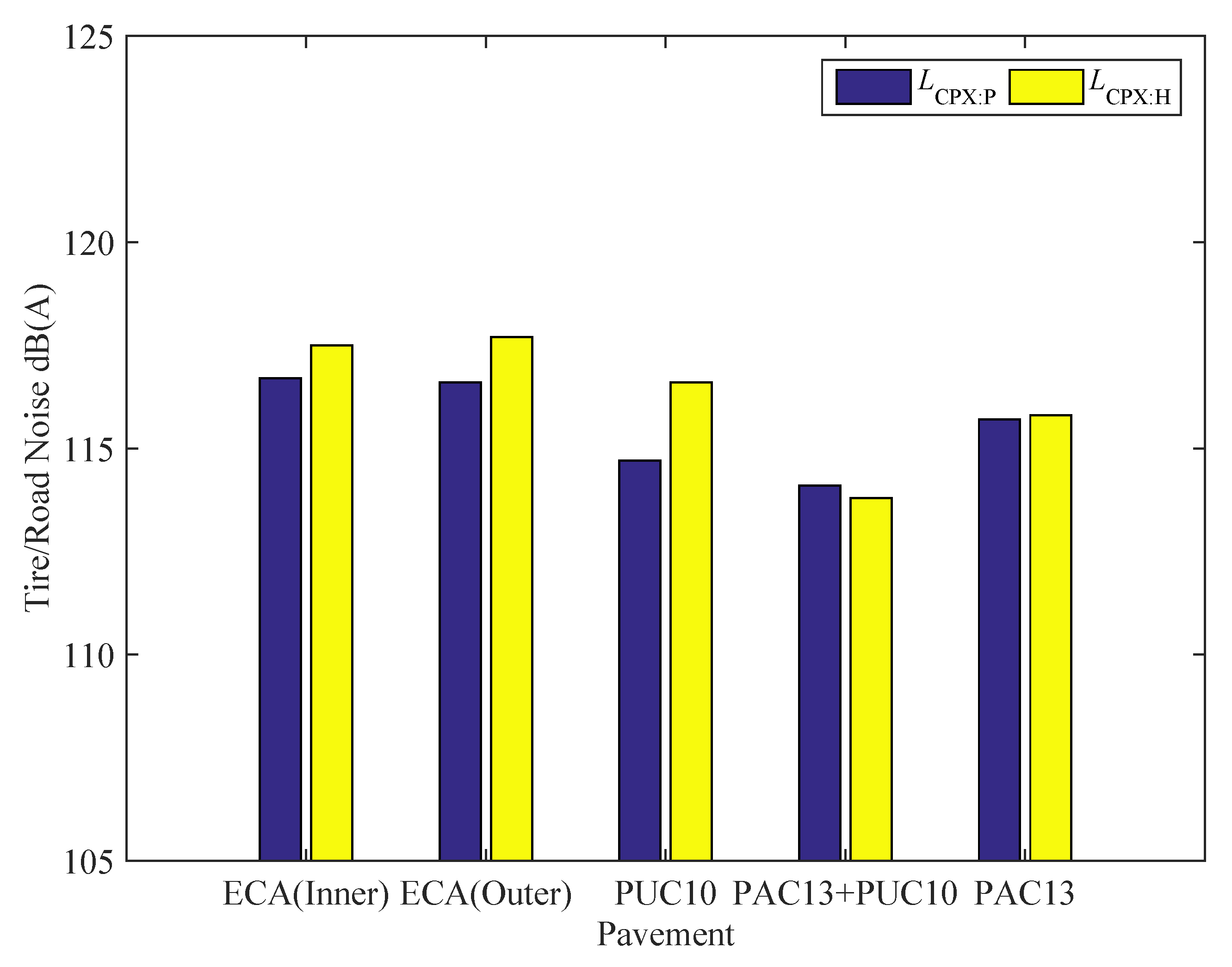
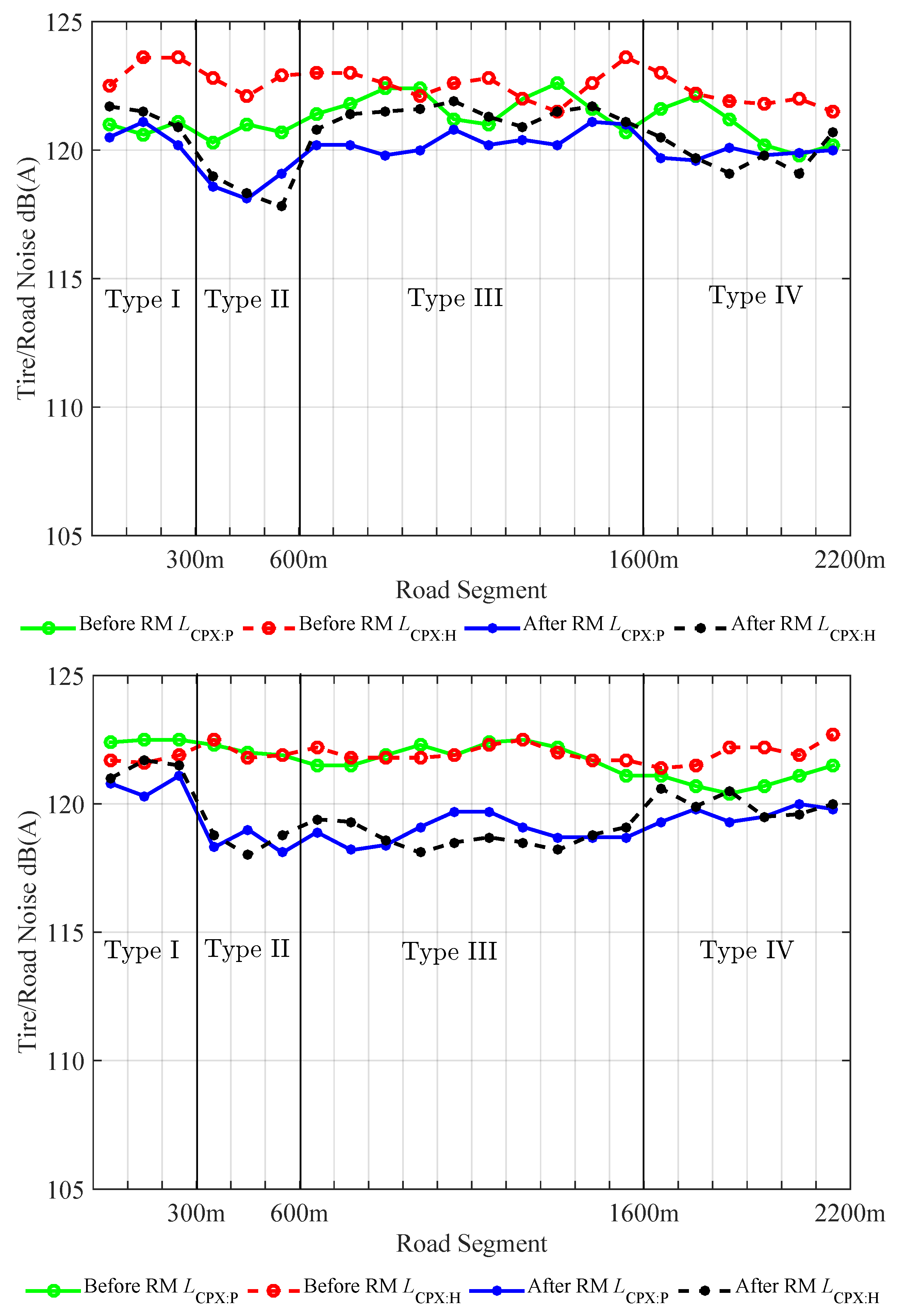
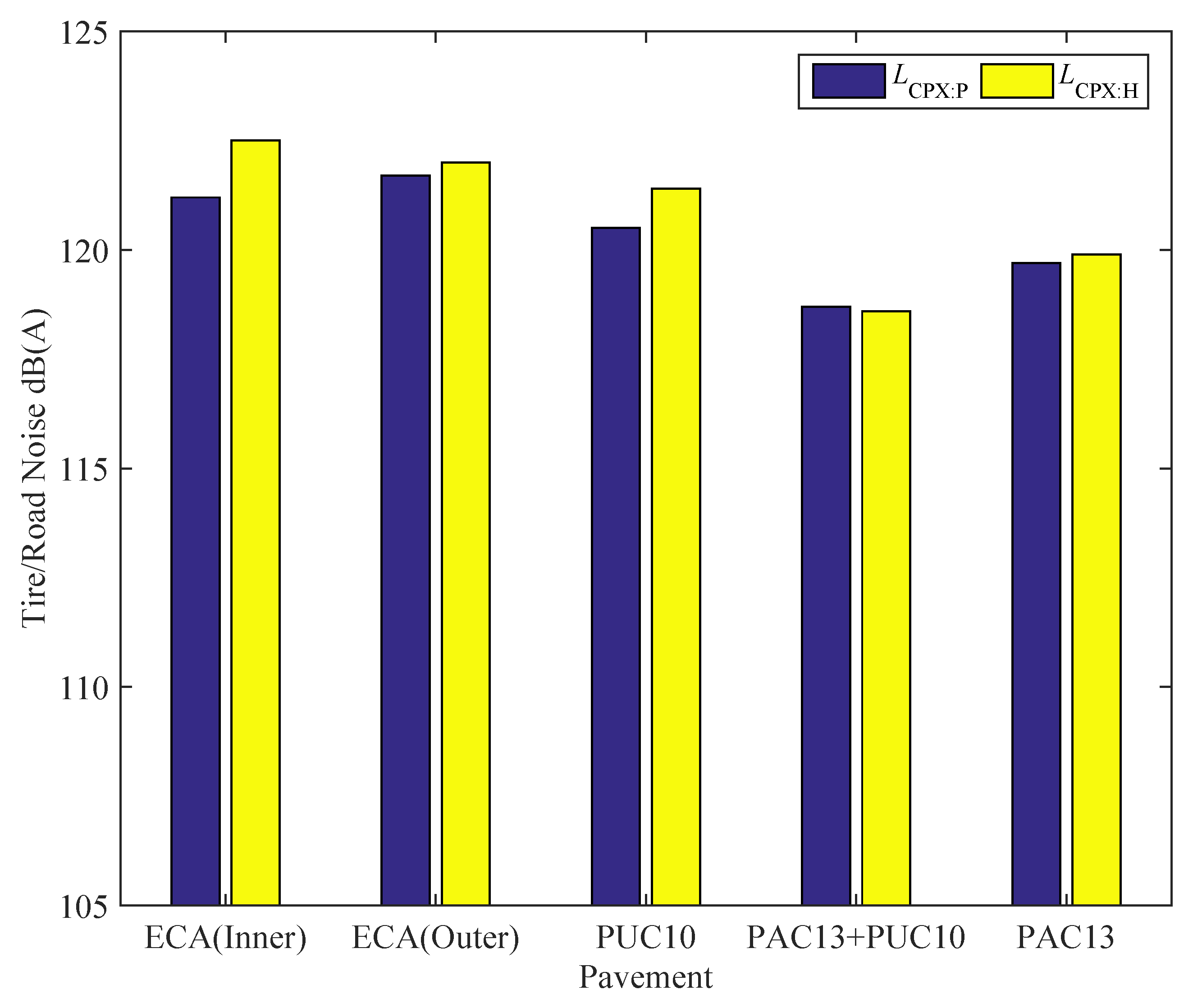
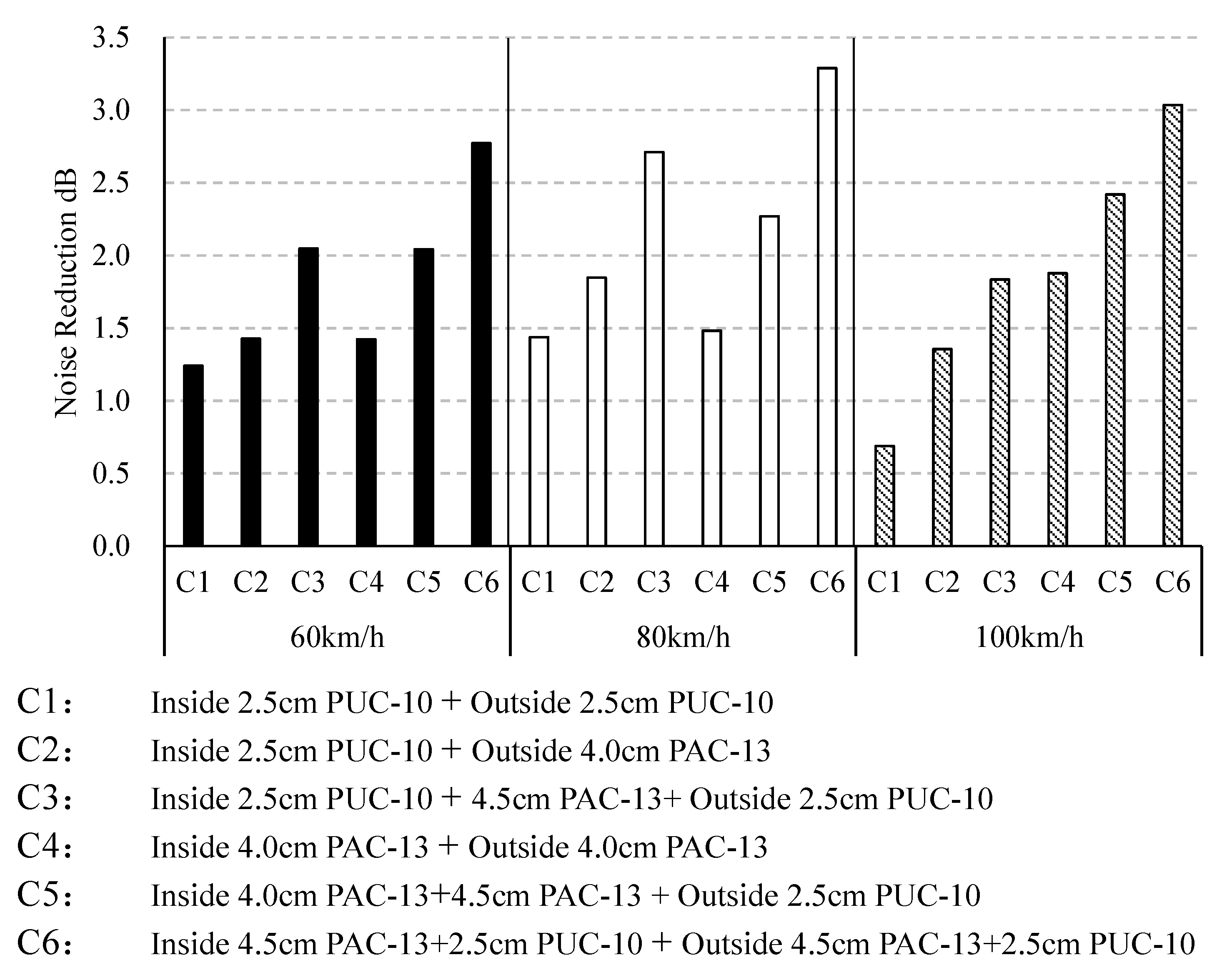

| Particle Size (mm) | PAC-13 | PUC-10 |
|---|---|---|
| 16 | 100.0 | |
| 13.2 | 91.0 | 100 |
| 9.5 | 62.1 | 99.2 |
| 4.75 | 18.1 | 25.3 |
| 2.36 | 10.8 | 12.3 |
| 1.18 | 8.7 | 10.4 |
| 0.6 | 7.5 | 7.9 |
| 0.3 | 6.6 | 6.6 |
| 0.15 | 6.1 | 5.6 |
| 0.075 | 5.4 | 4.8 |
| Else | 4.8% oil-stone ratio | 5.0% oil-stone ratio |
| 0.1% polyester doped | 0.1% polyester doped |
| Relevant Volume Parameters | PAC-13 | PUC-10 |
|---|---|---|
| Maximum theoretical relative density (g/cm3) | 2.674 | 2.655 |
| Gross volume relative density with volume method (g/cm3) | 2.067 | 2.077 |
| Void ratio with volume method (%) | 22.7 | 21.8 |
| Relative density of gross volume with vacuum method (g/cm3) | 2.142 | 2.105 |
| Void ratio with vacuum method (%) | 19.9 | 20.7 |
| Speed | Inner Lane | Outer Lane | (dB) | NR (dB) |
|---|---|---|---|---|
| 60 km/h | 2.5 cm PUC-10 | 2.5 cm PUC-10 | 110.0 | 1.2 |
| 2.5 cm PUC-10 | 4.0 cm PAC-13 | 109.8 | 1.4 | |
| 2.5 cm PUC-10 | 4.5 cm PAC-13 + 2.5 cm PUC-10 | 109.2 | 2.0 | |
| 4.0 cm PAC-13 | 4.0 cm PAC-13 | 109.8 | 1.4 | |
| 4.0 cm PAC-13 | 4.5 cm PAC-13 + 2.5 cm PUC-10 | 109.2 | 2.0 | |
| 4.5 cm PAC-13 + 2.5 cm PUC-10 | 4.5 cm PAC-13 + 2.5 cm PUC-10 | 108.4 | 2.8 | |
| 2.5 cm ECA-10 (Inside) | 2.5 cm ECA-10 (Outside) | 111.2 | − | |
| 80 km/h | 2.5 cm PUC-10 | 2.5cm PUC-10 | 115.8 | 1.4 |
| 2.5 cm PUC-10 | 4.0cm PAC-13 | 115.4 | 1.8 | |
| 2.5 cm PUC-10 | 4.5 cm PAC-13 + 2.5 cm PUC-10 | 114.5 | 2.7 | |
| 4.0 cm PAC-13 | 4.0 cm PAC-13 | 115.8 | 1.5 | |
| 4.0 cm PAC-13 | 4.5 cm PAC-13 + 2.5 cm PUC-10 | 115.0 | 2.3 | |
| 4.5 cm PAC-13 + 2.5 cm PUC-10 | 4.5 cm PAC-13 + 2.5 cm PUC-10 | 113.9 | 3.3 | |
| 2.5 cm ECA-10 (Inside) | 2.5 cm ECA-10 (Outside) | 117.2 | − | |
| 100 km/h | 2.5 cm PUC-10 | 2.5 cm PUC-10 | 121.0 | 0.7 |
| 2.5 cm PUC-10 | 4.0 cm PAC-13 | 120.3 | 1.4 | |
| 2.5 cm PUC-10 | 4.5 cm PAC-13 + 2.5 cm PUC-10 | 119.8 | 1.8 | |
| 4.0 cm PAC-13 | 4.0 cm PAC-13 | 119.8 | 1.9 | |
| 4.0 cm PAC-13 | 4.5 cm PAC-13 + 2.5 cm PUC-10 | 119.3 | 2.4 | |
| 4.5 cm PAC-13 + 2.5 cm PUC-10 | 4.5 cm PAC-13 + 2.5 cm PUC-10 | 118.6 | 3.0 | |
| 2.5 cm ECA-10 (Inside) | 2.5 cm ECA-10 (Outside) | 121.7 | − |
| Speed | Inner Lane | Outer Lane | (dB) | NR (dB) |
|---|---|---|---|---|
| Inside 80 km/h Outside 60 km/h | 2.5 cm PUC-10 | 2.5 cm PUC-10 | 113.5 | 1.6 |
| 2.5 cm PUC-10 | 4.0 cm PAC-13 | 113.4 | 1.7 | |
| 2.5 cm PUC-10 | 4.5 cm PAC-13 + 2.5 cm PUC-10 | 113.2 | 2.0 | |
| 4.0 cm PAC-13 | 4.0 cm PAC-13 | 114.0 | 1.2 | |
| 4.0 cm PAC-13 | 4.5 cm PAC-13 + 2.5 cm PUC-10 | 113.8 | 1.4 | |
| 4.5 cm PAC-13 + 2.5 cm PUC-10 | 4.5 cm PAC-13 + 2.5 cm PUC-10 | 112.4 | 2.8 | |
| 2.5 cm ECA-10 (Inside) | 2.5 cm ECA-10 (Outside) | 115.1 | − | |
| Inside 100 km/h Outside 80 km/h | 2.5 cm PUC-10 | 2.5 cm PUC-10 | 119.3 | 0.9 |
| 2.5 cm PUC-10 | 4.0 cm PAC-13 | 119.1 | 1.0 | |
| 2.5 cm PUC-10 | 4.5 cm PAC-13 + 2.5 cm PUC-10 | 118.8 | 1.4 | |
| 4.0 cm PAC-13 | 4.0 cm PAC-13 | 118.4 | 1.7 | |
| 4.0 cm PAC-13 | 4.5 cm PAC-13 + 2.5 cm PUC-10 | 118.0 | 2.1 | |
| 4.5 cm PAC-13 + 2.5 cm PUC-10 | 4.5 cm PAC-13 + 2.5 cm PUC-10 | 117.1 | 3.0 | |
| 2.5 cm ECA-10 (Inside) | 2.5 cm ECA-10 (Outside) | 120.1 | − | |
| Inside 100 km/h Outside 60 km/h | 2.5 cm PUC-10 | 2.5 cm PUC-10 | 118.4 | 0.8 |
| 2.5 cm PUC-10 | 4.0 cm PAC-13 | 118.4 | 0.8 | |
| 2.5 cm PUC-10 | 4.5 cm PAC-13 + 2.5 cm PUC-10 | 118.3 | 0.9 | |
| 4.0 cm PAC-13 | 4.0 cm PAC-13 | 117.5 | 1.7 | |
| 4.0 cm PAC-13 | 4.5 cm PAC-13 + 2.5 cm PUC-10 | 117.4 | 1.8 | |
| 4.5 cm PAC-13 + 2.5 cm PUC-10 | 4.5 cm PAC-13 + 2.5 cm PUC-10 | 116.4 | 2.7 | |
| 2.5 cm ECA-10 (Inside) | 2.5 cm ECA-10 (Outside) | 119.2 | − |
Publisher’s Note: MDPI stays neutral with regard to jurisdictional claims in published maps and institutional affiliations. |
© 2021 by the authors. Licensee MDPI, Basel, Switzerland. This article is an open access article distributed under the terms and conditions of the Creative Commons Attribution (CC BY) license (https://creativecommons.org/licenses/by/4.0/).
Share and Cite
Yuan, M.; Wang, J.; Wang, Y.; Shao, S. Study on Noise Reduction with Paving Different Low Noise Pavement Materials. Appl. Sci. 2021, 11, 10273. https://doi.org/10.3390/app112110273
Yuan M, Wang J, Wang Y, Shao S. Study on Noise Reduction with Paving Different Low Noise Pavement Materials. Applied Sciences. 2021; 11(21):10273. https://doi.org/10.3390/app112110273
Chicago/Turabian StyleYuan, Minmin, Jie Wang, Yanqin Wang, and Shegang Shao. 2021. "Study on Noise Reduction with Paving Different Low Noise Pavement Materials" Applied Sciences 11, no. 21: 10273. https://doi.org/10.3390/app112110273





